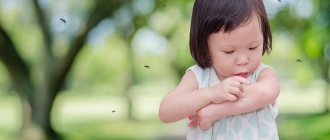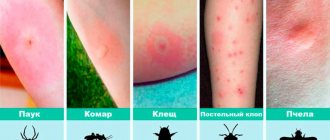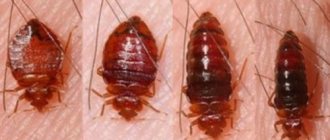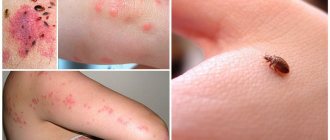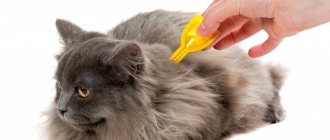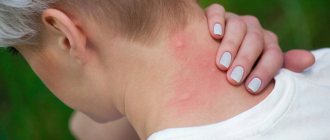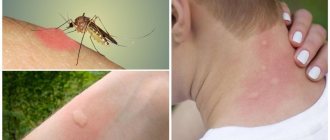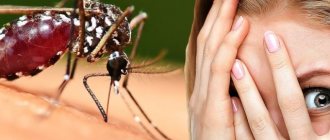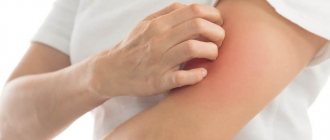Reasons for development
Allergy to insect bites is a serious problem faced by a significant proportion of modern children, despite the obvious successes of mankind in improving insecticidal agents that destroy blood-sucking parasites.
Three genera of mosquitoes are common in Russia. These are Culicidae, Anopheles and Aëdes corresponding to common, malarial mosquitoes and “biters”. The former mainly live in cities, living in semi-basements and basements, while the rest prefer natural conditions in close proximity to water bodies.
Blood-sucking mosquitoes can cause culicidosis, a pathological reaction to an insect bite. Only females feed on blood, since this biological substance is the basis of the egg reproduction cycle. When piercing the victim's skin, she simultaneously injects saliva into the wound, containing anticoagulants, complex proteins and other substances.
The immune system produces antibodies to the components of the insect's biological fluid. They actively interact with antigens and T-lymphocytes, which in turn leads to local cell damage and the release of histamine into the bloodstream. The intensity of the immunobiological reaction depends on a number of factors:
- The current state of the child’s immunity;
- Concentrations of allergens and their types in mosquito saliva;
- The presence of underlying acute and chronic diseases, including the autoimmune spectrum;
- Age and gender.
The pathological reaction in children after mosquito bites can manifest itself either slightly or systemically, creating the preconditions for severe complications, deterioration in quality of life, and chronic health problems.
Complications of allergies in children
The greatest danger in a child with allergies is represented by multiple bites, localized compactly. Such damage causes persistent local swelling, which can last for more than a month, and an increase in body temperature.
There are cases where an allergic reaction to mosquitoes led to the development of immunoinflammatory kidney disease - glomerulonephritis. This is a severe chronic lesion of the glomerular apparatus, the outcome of which is renal failure.
Signs and symptoms of mosquito bite allergy
The second type of complicated allergy to mosquito bites is a local or general inflammatory process. It develops initially from the fact that an infection was introduced into the wound by the insect itself. The bitten area begins not only to hurt and itch, but also to fester. With multiple injuries, the inflammatory process can become total.
Symptoms of general inflammation with an allergy to mosquito bites are pain and enlargement in the inguinal lymph nodes. Even dried “old” sores from scratching begin to fester throughout the child’s body. If the process is started, sepsis is likely.
Article on the topic: Which antihistamines are best to take for skin allergies in [y] year?
Allergy symptoms after mosquito bites
As modern clinical practice shows, mosquito bites in children cause local allergies, manifested by the following reactions:
- Severe itching and swelling in the bite area;
- Redness and hyperemia of the skin;
- Formation of a rash of urticarial or papular nature.
In the presence of increased sensitivity to the components of insect saliva, against the background of secondary presuming circumstances, prerequisites for more severe allergic manifestations are formed:
- Dermatic. They include the appearance of blisters, an extensive eczema-type rash, a change in the shade of the epithelium;
- Respiratory. Caused by a systemic immune response. Manifested by a dry cough, runny nose, itching in the nasal passages, wheezing in the lungs and attacks of suffocation;
- Visual. Tearfulness, severe irritation of the eyes, swelling of nearby skin are observed;
- Gastrointestinal. Rarely formed. Include colic, vomiting with nausea, constipation or diarrhea, and other dyspeptic disorders.
In the absence of first aid and proper subsequent treatment, complications arise as the pathology develops:
- Quincke's edema. Complex angioneurotic syndrome of allergic nature. It manifests itself as extensive swelling throughout the body. In the absence of conservative therapy, hypercapnia develops, the risks of coma and death increase;
- Anaphylactic shock. An immediate severe complication that develops within 5-20 minutes. Forms severe pain throughout the body, generalized itching, drop in blood pressure, bronchospasm, hypoxia, and fainting. The mortality rate from anaphylactic shock in children reaches 20 percent, even with medical care.
How long does an insect live after being bitten?
There is an opinion that the answer to the question “how long does a mosquito live after a bite” is a few seconds. This is an incorrect statement, since the female mosquito feeds for the purpose of reproducing offspring, and if she died immediately after saturation with blood, she would not have time to continue her life cycle. Therefore, after a bite, a mosquito lives from a few seconds (if you yourself killed it when found on your body) to several months (if it successfully ate and flew away to continue its life cycle).
So, we looked at how these insects bite, what to do to avoid worsening the situation, what cream will help fight the first signs of damage, and how long a mosquito that manages to bite a victim lives. Compliance with safety rules will reduce the likelihood of injury from these blood-sucking individuals.
First aid
As part of providing first aid to a child, the following actions are performed:
- Cold is applied to the swelling, constricting peripheral blood vessels and relieving itching and pain. It is more convenient to use ice wrapped in several layers of material. Time for one procedure is up to 15 minutes, after which you need to take a 10-minute break so as not to overcool the skin;
- The damaged areas are lubricated with soda solution. Recipe for the product: 1.5 teaspoons of the substance per glass of water;
- Available antihistamines are used orally - diazolin, loratadine or cetirizine;
- Ointments are applied to the skin - streptoderm, triderm or fluorocort.
The above steps only apply to mild to moderate allergies. If a severe systemic reaction occurs, consult a doctor immediately.
The use of folk remedies
Traditional medicine for the treatment of mosquito bites
The use of medications will not be necessary if, after providing first aid to the baby, you use time-tested folk remedies.
- Aloe juice can relieve allergy symptoms. It is rubbed into the skin at the site of the bite.
- Vinegar solution effectively relieves obsessive itching from bites of blood-sucking insects. To prepare it, vinegar is diluted with water in a ratio of 1:3. You can also use apple cider vinegar, provided that the baby's skin is not damaged from scratching. Vinegar is also used to repel mosquitoes.
- Soda lotions help a lot. It is necessary to stir 1-2 tsp in a glass of water. baking soda, soak a bandage or gauze in the resulting solution and apply to the affected area.
- You can also make a thick paste from water and baking soda, which, when applied to the bite site, will provide pleasant relief from the itching.
- Children under one year old use fermented milk products (kefir, yogurt or sour cream) to relieve itching and irritation.
- Onions will help relieve discomfort after a mosquito attack. It is enough to cut it and wipe the cut area on the affected area of the skin.
- To relieve itching, use plantain, mint or parsley juice.
The use of folk remedies is especially important for children under one year of age, due to the fact that not all ointments are suitable for infants. Special mosquito repellents are also produced for children under one year of age, which will help protect the baby from the attacks of blood-sucking insects.
Outpatient and inpatient treatment
If a severe form of pathological reaction to mosquito bites develops, the child is subject to outpatient treatment or hospitalization. The specific treatment regimen and duration of drug use are prescribed exclusively by the doctor. The last one is a pediatrician, allergist, dermatologist, resuscitator and other specialized specialist as necessary.
Emergency care for the development of anaphylactic shock
It is performed in an intensive care unit or by an ambulance team arriving at the scene. General scheme:
- Apply a tourniquet above the mosquito bite.
- Use of adrenaline. Intravenous administration. Dosage – 0.2-10 milliliters of a 0.1 percent solution, depending on the severity of the condition and signs of swelling of the respiratory system.
- Prednisolone injections. Intramuscular administration. Dosage – 1-5 milligrams of glucocorticosteroid per 1 kilogram of the child’s body weight, depending on the severity of the condition.
- Administration of antihistamines. Slow intravenous injection. The drug of first choice is suprastin or tavegil. For bronchospasm, aminophylline is used. Dosage – 1-10 milliliters of the drug, depending on the severity and stage of anaphylactic shock.
- Intubation. It is performed when acute respiratory failure increases, threatening suffocation for a small patient. The first choice procedure is endotracheal tube insertion. If it is ineffective, a conicotomy or tracheotomy is performed.
Subsequent treatment after overcoming the most acute period of the allergic reaction includes the use of leukotriene inhibitors, decongestants, as well as concomitant symptomatic therapy and protection of the child’s internal organs. A wide range of drugs is used - from cardiovascular drugs, anticoagulants, hepatoprotectors to vitamin-mineral complexes and intravenous drips of saline and glucose.
Treatment with folk remedies
If the manifestations do not cause concern, then you can get rid of itching and discomfort using improvised means that have proven themselves since ancient times.
Here I have collected some of the most effective ways to relieve suffering, both old and new.
- Baking soda and water are mixed to a paste consistency and applied (smeared) onto the bitten area. Perfectly helps relieve severe itching and redness in just a few minutes.
- Salt with water. Crushed “Extra” salt is required. Use the same as baking soda. Blisters and pain will quickly disappear.
- Garlic is an effective remedy. Lubricate the area with a cut clove of garlic: it will prevent the appearance of blisters and relieve all unpleasant sensations.
- Apply ammonia diluted with water in equal proportions to a cotton pad. Wipe the surface of the body - relieves redness and itching.
- Regular 72% laundry soap (one that does not contain bleaches).
Lather the affected areas thoroughly, give it a few minutes to act, and rinse.
- If you lubricate the wounds with cologne, alcohol, or brilliant green, this will ease the itching and prevent serious consequences.
- Mint toothpaste (powder) or deodorant is applied exclusively to the wound.
- Lubricate the sore spot with sour cream.
Folk remedies for allergies after mosquito bites for children
Official medicine does not recommend using traditional medicine recipes. Non-traditional remedies contain herbal components that can independently act as allergens for the child’s body, which can lead to the development of additional complications - Quincke’s edema, anaphylactic shock.
In some cases, it is allowed to use traditional medicine recipes after the end of the acute phase of the allergic reaction as an addition to drug therapy. Procedures require mandatory approval from the attending physician!
- A series. One teaspoon of the product is brewed in 300 milliliters of boiling water, after which it is used as a replacement for tea;
- Celandine. One tablespoon of dry herb is brewed in 500 milliliters of hot water, infused for 3 hours. The liquid is filtered and consumed 1/4 cup 3 times a day;
- Celery. From 15 fresh bunches of the plant you need to extract liquid using a juicer. 3 teaspoons of sugar are added to the product, after which the juice is mixed, infused for 30 minutes and consumed 1 tablespoon 2 times a day 1 hour before meals.
How to treat a mosquito bite on a child?
Due to age-related characteristics, children's delicate skin is extremely susceptible to irritation and all kinds of rashes. Including, even the most ordinary mosquito bite can cause redness, itching, swelling and other unpleasant symptoms.
Since babies experience any illness very hard, parents want to relieve them of signs of discomfort as quickly as possible. In this article, we will tell you how you can treat mosquito bites on a child in order to tidy up the skin and alleviate the baby’s condition.
How to treat a child's skin after a mosquito bite?
First of all, the site of the insect bite should be washed very well with warm water and soap that has an antibacterial effect. This must be done in order to remove existing contaminants and microbes in order to avoid the development of an infectious process. After this, the bite should be very carefully blotted with a soft towel, but under no circumstances should it be rubbed.
Next, apply a cold compress to the affected area for 10 minutes. This could be ice wrapped in a piece of thick cloth, a towel soaked in cold water, or a chilled can of soda. If the child does not resist, repeat this procedure every hour for 5-6 hours, and then as needed.
If the bite site in a child is very itchy, it is allowed to use any antihistamine approved for use in children. In particular, Fenistil or Zyrtec drops are suitable for babies from birth. You can anoint the affected area with hydrocortisone ointment or Akriderm - these medications are suitable for use in children over 12 months. Among medications in the form of ointment or gel, there is also something that can be used to treat the site of a mosquito bite in a child under one year old, for example:
- La-Cri, Baneocin - for babies from the first days of life;
- Fenistil-gel – for babies older than 1 month;
- Advantan – for children from 4 months and older.
Among traditional methods there are also interesting and effective options. Of the things that can be used to treat a mosquito bite on a one-year-old baby or an older child, the most popular are the following:
- Combine baking soda with clean water in a 3:1 ratio and mix well. You should get a thick, homogeneous paste, which must be applied to the bite site several times a day. This product is suitable for babies from the first days of life and older children with hypersensitive skin.
- Peppermint, tea tree and eucalyptus oils, as well as an effective mixture of these components, help very well.
- It is useful to lubricate the bite site with natural aloe juice. This product quickly relieves irritation and soothes the skin.
- If the affected area is very itchy, try rubbing it with the inside of a banana peel. This remedy effectively reduces itching and promotes healing.
- Gently apply a small amount of ammonia to the mosquito bite using a small piece of cotton wool.
- Finally, the use of toothpaste in the fight against mosquito bites is deservedly popular among adherents of traditional medicine. Simply apply this product to the affected area and wait until it dries completely, then carefully remove the residue with a dry cloth.
The most important thing in treating a mosquito bite is to not allow your child to comb or scratch it. Otherwise, the child’s body produces histamine, which makes the affected area itch even more. In addition, such actions can provoke the development of an infectious process and cause the appearance of a scar.
← Click “Like” and follow us on Facebook
The delicate skin of babies is often the first target for mosquitoes. But it is much more difficult for such babies to cope with unbearable itching than for adults, and mothers want to quickly alleviate the painful discomfort and prevent scratching.
The rules for transporting children are, first of all, created for the safety of the children themselves, which is in the interests of parents, so they should know them well. Let's look at this information in detail.
Walking is important and beneficial for any person, especially for a child whose body is constantly growing and improving. Why you need to walk with your children every day in any weather, we will tell you further.
Baby swimmers cannot control their bowel movements, so waterproof swim diapers were invented to allow them to exercise in the pool.
Prevention measures
There are no specific medications or vaccines against allergies. General preventive actions include preventing direct contact of the child with mosquitoes. Possible procedures involve the use of:
- Insecticidal repellents. It is possible to use fumigators at home (plates, liquids in containers) or creams or sprays on clothes/skin when the child is outside. The insecticides purchased must be safe for children;
- Dense mosquito net. It can be placed both in a nursery or other room where the child is constantly located, and on a stroller for walks in the fresh air;
- Ultrasonic mosquito repeller. A stationary emitter is installed in the room, operating from a household power supply. For outdoor walks, a portable version of the device is used, powered by batteries and rechargeable batteries and attached to clothing or a stroller.
Treatment honey. drugs
Swelling from a mosquito bite in a child requires immediate and mandatory consultation with a doctor. This phenomenon can lead to the most serious consequences: suffocation, severe allergic reactions, anaphylactic shock and other complications, even death.
Treatment is carried out with medications orally - these are antihistamines, sedatives and anti-inflammatory drugs, and externally.
The range here is very large: sprays and ointments that reduce pain and itching. However, infants and children under two years of age cannot take most of these drugs. Therefore, it is better to resort to folk remedies.
Older children are given appropriate doses of antiallergic drugs, and if the situation becomes more complicated: an increase in the area of edema, breathing problems, the appearance of hives and similar phenomena, an ambulance should be called immediately.
If such a problem arises, then it is necessary to obtain full information from the doctor about what medications you should always have with you in order to use them immediately if such a reaction of the body recurs.
The drug, dosage and course duration are prescribed by the doctor.
